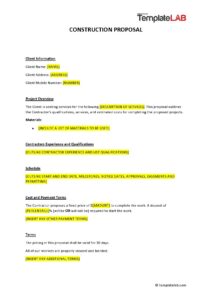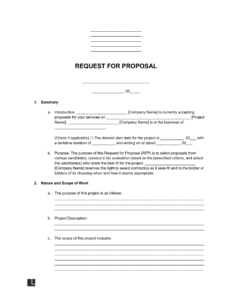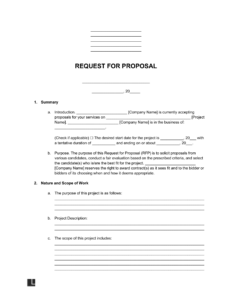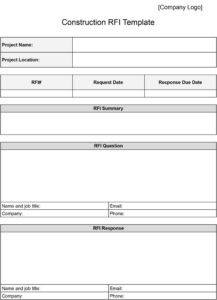Utilizing a formal structure for soliciting engineering support offers numerous advantages. It promotes consistency and reduces ambiguity in project specifications, leading to more accurate bids and minimizing potential misunderstandings. This, in turn, can save time and resources, improve project outcomes, and foster stronger client-consultant relationships. Furthermore, a well-defined format enables efficient comparison of proposals from different firms.
This structured approach to procuring engineering services forms the foundation for successful project execution. The following sections will explore the key components of such forms, best practices for their development and implementation, and practical examples illustrating their effectiveness.
Key Components of an Engineering Service Request Form
Effective solicitation of engineering services relies on a well-structured request form. Essential components ensure clarity, completeness, and facilitate efficient evaluation of proposals.
1. Project Overview: A concise description of the project, its objectives, and desired outcomes is fundamental. This section sets the context for the entire request.
2. Scope of Work: Detailed specifications of the required engineering services, including tasks, deliverables, and responsibilities, must be clearly articulated. This section minimizes ambiguity and ensures accurate bidding.
3. Timeline and Milestones: A realistic project schedule with key milestones and deadlines is essential for effective project management. This allows firms to assess feasibility and allocate resources appropriately.
4. Budgetary Considerations: Providing a clear budget framework, whether a fixed price or a range, enables firms to tailor their proposals accordingly and ensures financial transparency.
5. Deliverables Format: Specifying the required format for deliverables, such as reports, drawings, and specifications, ensures consistency and compatibility with internal systems.
6. Contact Information: Designated points of contact for inquiries and communication throughout the procurement process streamline information flow and facilitate prompt responses.
7. Submission Instructions: Clear guidelines for proposal submission, including deadlines, formats, and required documentation, ensure a fair and organized evaluation process.
8. Evaluation Criteria: Outlining the criteria for evaluating proposals, such as experience, technical expertise, and cost, promotes transparency and allows firms to understand the selection process.
A comprehensive request form incorporating these elements provides a solid foundation for procuring high-quality engineering services, leading to successful project execution and client satisfaction.
How to Create a Request for Engineering Services Template
Developing a standardized template for requesting engineering services ensures consistency, clarity, and efficiency in the procurement process. A well-structured template facilitates clear communication of project needs and allows engineering firms to accurately assess requirements.
1. Define Project Objectives: Begin by clearly articulating the project’s goals, desired outcomes, and overall purpose. This provides context and clarifies the scope of required services.
2. Detail the Scope of Work: Specify the tasks, deliverables, and responsibilities required from the engineering firm. Include specific technical requirements, performance criteria, and any regulatory considerations.
3. Establish a Timeline: Outline a realistic project schedule with key milestones and deadlines. This allows firms to assess feasibility, plan resource allocation, and manage expectations.
4. Determine Budgetary Parameters: Establish a clear budget framework, whether a fixed price, a range, or an hourly rate. Transparency in budgetary considerations facilitates accurate bidding and informed decision-making.
5. Specify Deliverables Format: Define the required format for deliverables, such as reports, drawings, calculations, and specifications. This ensures compatibility with internal systems and facilitates seamless integration.
6. Outline Submission Requirements: Provide clear instructions for proposal submission, including deadlines, accepted formats, and required documentation. This ensures a fair and organized evaluation process.
7. Establish Evaluation Criteria: Define the criteria for evaluating proposals, such as experience, technical expertise, proposed methodology, and cost. Transparent evaluation criteria promote fairness and allow firms to understand the selection process.
8. Incorporate Legal and Contractual Considerations: Include standard legal clauses, intellectual property provisions, and confidentiality agreements as necessary. Consulting with legal counsel is recommended to ensure compliance and protect all parties involved.
A comprehensive template incorporating these elements streamlines the procurement process, promotes clear communication, and increases the likelihood of successful project outcomes. Regular review and refinement of the template based on project experience and industry best practices contribute to continuous improvement in procuring engineering services.
Standardized forms for soliciting engineering services provide a crucial framework for successful project delivery. From defining project scope and budgetary constraints to outlining deliverables and evaluation criteria, a well-crafted structure ensures clarity, transparency, and efficiency throughout the procurement process. This meticulous approach minimizes potential misunderstandings, facilitates accurate bidding, and ultimately fosters stronger client-consultant relationships. By promoting consistency and enabling effective comparison of proposals, these structured documents contribute significantly to informed decision-making and optimized resource allocation.
Effective utilization of these standardized forms represents a commitment to best practices in engineering project management. Adoption of such streamlined processes empowers organizations to procure high-quality engineering services, mitigating risks and maximizing the potential for successful project outcomes. Continual refinement of these templates, incorporating lessons learned and evolving industry standards, remains essential for optimizing engineering service procurement and achieving project excellence.



